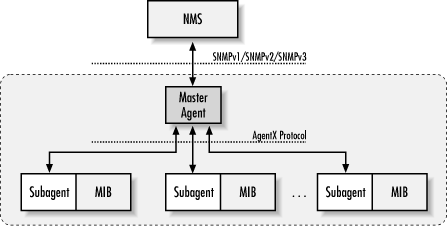
4.5. A Look Ahead
The Internet Engineering Task Force (IETF) is in the process of defining a standards-track technology for SNMP agent extensibility (AgentX). As we defined it earlier, an SNMP agent is software that resides on a managed device, replying to SNMP requests and generating asynchronous traps. Information about agent extensibility can be found in RFC 2741, as well as at the AgentX web site, http://www.scguild.com/agentx/. The need for AgentX arises from the inability to add and remove MIB objects while an agent is running; in other words, the lack of a standard way to extend an agent's functionality. The SNMP Multiplexing Protocol (SMUX, RFC 1227) was an early attempt to provide standardization for agent extensibility, but the protocol was found to be flawed and has since been abandoned. Figure 4-1 is an overview of the AgentX architecture. With AgentX, the agent consists of a single processing entity called a master agent and zero or more processing entities called subagents. The master agent and subagents can reside on the same device or communicate via a proxy device. The master agent communicates with the NMS, much like a traditional SNMP agent. The subagents have direct access to the MIB, whereas the master agent does not. Consequently, the subagents perform management functions on managed variables, then communicate this information to the master agent via the AgentX protocol, which is not SNMP-based.
Figure 4-1. AgentX architecture
Without a standardized approach to extensibility, it is very difficult for vendors to keep track of extensions to agents for the various platforms they support. AgentX tries to address this by giving vendors a consistent interface for extending agents. It also establishes the notion of MIB regions, or sets of managed variables. A subagent is responsible for registering these MIBs with a single master agent. In practice this means that vendors will have a subagent for each MIB they implement; for example, an RMON subagent, a MIB-II subagent, a Host Resources subagent, and others. This helps vendors because it gives them a way to add and remove MIB instances from an agent without disturbing the actual operation between an NMS and the agent.
Copyright © 2002 O'Reilly & Associates. All rights reserved.



